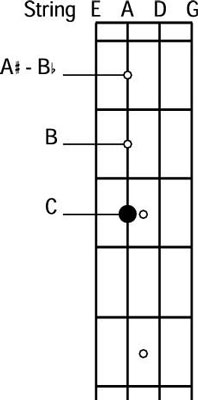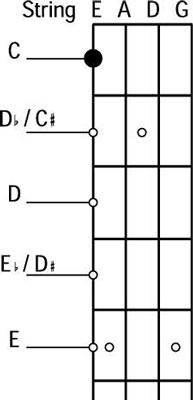Any of your patterns (except for the open E and A scales) work in all keys on the bass guitar. Because you can transpose these patterns to any key, all you have to do is nail the root with the proper finger of the left hand (usually the middle finger for the major patterns and the index finger for the minor patterns), and you're in position.
Only one question remains: How do you find a certain key when someone asks you, for example, to play in C?
The sides, and sometimes the top, of your bass's neck are marked by dots. These dots are your landmarks for determining where a note is located. After you find a note, use the dots as a reference to find the note again. The notes are organized in a sequence of half steps, which are the smallest step in music (at least in music of the Western hemisphere).
Each half step is one fret. The order of notes in half steps is: C, C♯ (pronounced “C sharp”) or D♭ó (pronounced “D flat”), D, D♯ or E♭ó, E, F, F♯ or G♭ó, G, G♯ or A♭ó, A, A♯ or B♭ó, B, and C. Notice that some of the notes have two names.
For example, C♯ and D♭ó are the same note. (It's a half step above C or a half step below D.)
The notes on the open strings of your bass are tuned (from low to high) E, A, D, and G (the thinnest string). You can start from any open string and count the half steps to find a specific note.
For example, to find your C on the A string, your 1st fret on the A string is A♯ or B♭ó, the next fret is B, and the one after that is C (the fret with the first dot).

If a note is raised by a half step (one fret), it has a ♯ (sharp) symbol next to it. For example, if you take the C that's played on the 3rd fret of the A string (the second thickest string) and raise it a half step to the 4th fret, it becomes C♯.
If a note is lowered by a half step, it has a ♭ó (flat) symbol next to it. For example, if you want to lower the B that's on the 2nd fret of the A string by a half step, press the string to the 1st fret and the B becomes B♭ó.
Your bass has two dots on the 12th fret. These dots are your octave marker for the open strings. By pressing down any string at the 12th fret and striking it, you produce the same note you get when playing the open string, but the note is an octave higher.
If you want to find your C on the E string, you can start on the E-string octave marker and go backward: E, E♭ó or D♯, D, D♭ó or C♯, and C. The C note is four frets below the octave marker, between the third and fourth dots of the E string.


